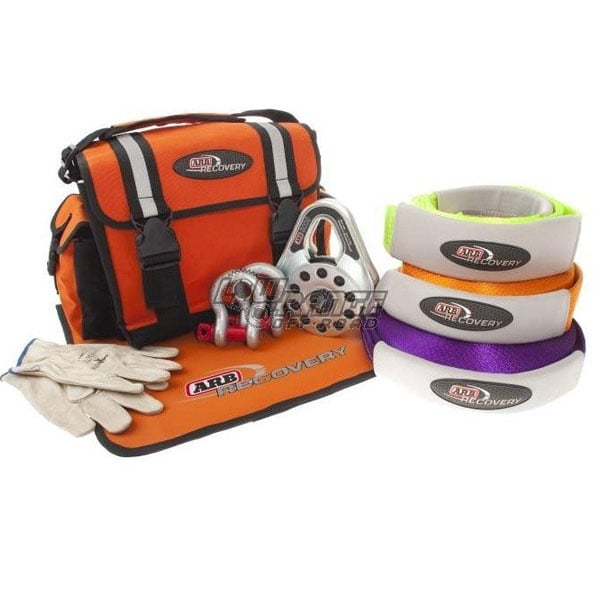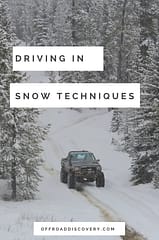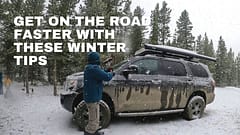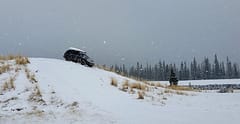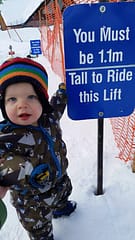Guidelines to Driving on Snow and Ice
Interesting Stuff Snow!
Contents
Introduction
Interesting stuff Snow!
If I may, I’ll start this article off with a bit of humour as it hopefully will bring folks a better understanding of Snow and Ice.
I first came across the “White Stuff” in the late 1940’s the morning after one of the UK’s major blizzards. A family member was all excited to show it to me. I stood in awe as they opened the front door and they were shouting something that to me sounded like “Dwift” – Look, a big “Dwift.” Towering above me the full height of the door-frame was this large “Dwift” of the stuff. I stuck out my hand and had my first lesson about Snow; sometimes it has no support strength. It all fell in through the doorway and buried me; didn’t take much to do that as I was only 2 years old at the time.
This content was developed by and owned by Paul Sinkinson, Xplorability owner. Paul is a 4wd Defensive Driver Training Consultant/Trainer and Programme Developer.
In the 1950’s, the learning curve continued when I found the difficulties of riding your bike in the stuff. This was followed after watching older kids with toboggans zooming down hills; I didn’t own one but I did find that excitement could be achieved if you laid on top of your violin case on a downhill snow slope and steered with the toes of your wellington boots. Apparently as well as sometimes having little strength, snow is also slippery stuff. With my track record on personal accidents, I never “inhaled” when it came to that Ski Sport, as it was, the family had already moved nearer to the local hospital A & E department for ease of access.
The start of 1960’s passed in a haze of learning to ride on the limited amounts of winter white on various motorcycles before doing the same with my first cars and eventually a Land Rover Series 1, (that was the start of my love affair with all the “Doris’s” as they came to be referred as). Although having the Series 1, necessity required ownership of other vehicles and the Snow Experiences and the learning curve continued; to some extent the curve became a straight line at one point as I progressed onto the delights of unexpected snow combined with ice.
The Fiat 124 (going slowly) in 18 inches of snow didn’t follow my input going round an industrial estate corner and in an attempt to avoid our local Politician’s stationary V8 Rover I found that the appliance of one’s brakes brings on the same experience as I had sliding along on the violin case mentioned earlier although, I couldn’t steer with my wellington boots so the Fiat impressed itself on a granite wall.
Further Black Ice experiences came about with a TVR Grantura after a Christmas Freeze following a rain-storm when I found that gravity means water runs down and collects at the base of hills and Power Provides Pirouettes when frozen.
Up to this point in my vehicle ownership, steering involved the application of muscle power. Cue 1970’s and “Power Steering” on my Jaguar XJ6. The one thing you lose with power steering is “Feel,” the sensitivity, the connection between you brain, your hands and the anal nerve. The first time you hit black ice, spin and slither off the road between those large upright brown and green woody things, you regain the “Feel,” however it usually requires a visit to the Laundry.
The 1980’s and early 90’s passed without too many Snow and Ice issues due to Global Warming and flooding but the late 90’s provided more ways to straighten the curve when exploring the heights of the Yorkshire Dales in mid winter which resulted in numerous bogging’s in and recovery experiences. The early part of this Century added to them with an “interesting” Torville & Dean” excursion surrounded by a French ditch when education was expanded following Black Ice formed beneath 18 inches of Snow on a short stretch of rural road because it was shaded from the Sun by a high bank of pine trees. A Discovery 2 Traction Control System does not help much when you are sliding sideways in such conditions and likewise Centre Diff-Lock doesn’t respond with your natural preservation reaction when you are straining at the lever, IF it isn’t fitted to the vehicle.
So, what did I learn over those early years?
- Snow may be Fragile and offer no support.
- It is slippery
- Offers little support to a braking vehicle
- It freezes and turns to ice
- Sometimes you can’t see the ice
- When combined, snow over ice is extremely dangerous
- Black Ice is scary stuff in ANY Vehicle
- Practise doesn’t make Perfect – It’s a Lie BUT it does help you understand the issues better.
- A learning Curve is often Straight
Punching through deep snow drifts is not a good idea – Especially if you have a multitude of under vehicle bash plates – Here, the Defender is sat on top of the compacted snow with ALL four wheels off the ground.

Example Only: DON”T Drive around like this. After a Snowfall, don’t be lazy. Make sure you clear ALL the Snow from the Vehicle’s Roof and Hood/Bonnet. Clear ALL the Windows and Screen and also the Mirrors and ALL the Lights and Indicators. Loose snow falling from the Roof or blowing up from the Hood/Bonnet can be a distraction to the driver. Lift the Windscreen Wiper Blades OFF the Windscreen before Clearing and more carefully if they are frozen on. DO NOT try and clear snow from the screen using the Screen Wipers as there is too much strain. Scrape any ice from ALL the Glass areas.
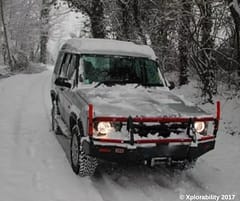
Basic Guide to 4wd Driving on Snow and Ice
This article is a brief and basic guide to driving in Snow and Ice conditions and we do recommend if possible that you take a course on Snow/Winter Driving with a suitably qualified 4wd Professional.
Do you understand your Vehicle 4×4 system?
Before you undertake ANY Off-Road situations, to make the most of your 4×4, you need to be fully conversant with understanding how the vehicle systems work so you to know how to benefit the most from them. The various traction control systems available on most modern vehicles can assist you however, you still need to understand how they work, how they can help just in case they fail, which they sometimes do. Check out the earlier articles on the Training area of the website about Hi/Low Range ABS/TC/CDL/HDC systems. It is also important to read the Hazard Awareness information. Do that now before you continue to read the rest of this article.
Preparation and Equipment (Snow & Ice Conditions)
Whenever you are likely to be driving in adverse conditions you need to plan and prepare for it. Pack some extra warm clothing, basic energy food, water, a torch and a first aid kit; these should be the minimum requirements. The following items should also be considered:
- Sleeping Bag and Blankets – Sufficient for all
- Basic recovery equipment with rated Strops and Shackles
- A Snow Shovel
- Suitable Traction Aids such as Sand Ladders/Snow Mats
- Windscreen Scrapers
- If you have a vehicle winch fitted, make sure it is in working order and maintained/greased up etc.
- Communications Device (Phone, ERPB, CB)
- GPS Device (or Maps)
- Suitable Tyres for the conditions
- Snow Chains – Except for certain areas, Snow Chains are not in common use in such as the UK but should be considered if you are likely to travel in snow in those regions. In many parts of Europe and other Countries Snow Chains are mandatory in Mountain Regions and areas of regular heavy snowfall. Ensure you have that requirement and the knowledge of when and how to fit and use them for your vehicle.
- Make sure you tell someone where you are going and an ETA for your destination, set a deadline regarding Emergency Response
Example recovery kit
This basic Snow Driving guide is based around the modern 4wd vehicles, which are likely to be either Permanent 4wd or Part Time 4wd. There are of course a number of common SUV’s about these days, which only have 2wd so owners of those vehicles need to be aware of the needs for driving in adverse conditions for their particular model.
Some SUV’s with 4wd capability are basically 2wd vehicles that have a viscous coupling or other device that activates the transmission as the terrain/situation/traction requirements demand and engages the other axle/wheels to commit to 4wd. Many of these vehicles do not have a Low Transfer Box range of reduction gears.
As mentioned earlier, familiarize yourself so that you fully understand the vehicle’s 4wd system and various controls systems. If you can find a suitable snow covered area such as an empty car park, you can try out the vehicle systems and responses to speed, braking, traction, skids and recovery etc. Do it safely without using chains (to avoid surface damage). Make sure there are no vehicles or pedestrians anywhere near and drive with responsibility, not idiotically.
Off-road winter gathering - practicing techniques in a group
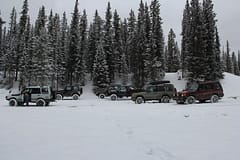
General Points: BE AWARE OF THE WEATHER FORECAST – Also…
- For general Snow Driving you will use High Range Gears however, for more positive control use Low Range Gears where applicable
- On Snow Surfaces engage Centre Diff-Lock (CDL) if fitted, as soon as the conditions become slippery but disengage when on solid ground/tarmac
- If the vehicle has the facility to raise the suspension (air etc.) raising this may over give better clearances in deep snow
- When starting off from rest, use a higher gear than normal for better traction, as this should avoid wheel-spin.
- Keep your speed down
- Keep your distance - Ensure you leave plenty of room for braking and ensure both acceleration and deceleration are carried out gently – Use engine braking rather than the footbrake
- Steer positively but NOT abruptly as this may cause a skid
- Continually update Hazard ID and Safety Margin checks
- Beware of uncontrolled momentum. IE: Avoid sudden speed and direction changes
- Exercise extreme care when using brakes or accelerator
- The vehicle is unlikely to make progress in snow drifts above bumper height
- Beware of hidden obstacles ie: Rocks, gullies etc.
- Tyre chains will assist in snow conditions but don’t assume they will prevent a slide on sheet ice.
- The recommendations are always to fit chains to all 4 wheels however, if only 2 chains are available, fit these to the rear wheels while ascending (But be aware of the steering limitations on ascents as the front wheels will become lighter as the weight transfers to the rear). Fit chains to the front wheels while descending but remember the rear will become lighter. When driving on more normal terrain fit the chains to the front wheels front as this assists directional control. Be aware that although you have front directional control, the rear may slide if you drive aggressively
- In snowy conditions, regardless of your vehicle type, there is no special formula that allows you to travel any faster than the next person. Drive sensibly without haste. Arrive Safe.
- REMEMBER! Make sure you allow much larger than normal safety margins and following distances.
- When parking on slippery surfaces always try and park on level ground. Engage 4wd, apply Centre Diff-Lock (if fitted), and leave Manual main transmission in gear, LOW Range. Automatics engage Park. If you use the hand brake remember, if wet, if left for any length of time this can freeze on.
- Make sure you keep an eye on the time. It gets dark early in these conditions. Finish YOUR DAY early. Avoid that “Last” run of the day as that’s usually when things go wrong – Just as “Darkness” falls. That’s when the TROUBLE STARTS!
Moving Off
To ensure you pull away smoothly in snow, make sure you have the 4wd fully engaged and if in deep snow perhaps engage the Centre Diff-Lock (CDL) and if the situation dictates, engage Low Range. Some will just try and get away and let the Traction Control (TC) do the work but remember, for TC to work you first have to lose traction to regain it which means you will have incurred wheel-spin. If a wheel spins, you are already making hard work of it. If you have CDL then best to use it should you wish as this reduces the need for the TC to work so hard. You can then disengage it if required but at least by then you are off and away. Always disengage CDL if the Terrain is a hard surface (Tarmac etc.) to avoid transmission wind up of the gears.
Once you have finished this article, go back to our previous article on ABS/TC/CDL and HDC as this will give you a fuller understanding of the systems we are discussing here.
We mentioned earlier, it is best to start off in snow in a High Gear, you would certainly do this in your average 2wd standard car and of course you can use High Range in a 4wd however, usually, if you have Low Range, you are better setting off in the higher gears of that as this provides the more controllable engine torque and traction. You can then change into High Range on the move within the designated speed limitations for the system.
Now you’re on the move and making progress on your chosen off-road track it’s time to keep an eye on the terrain ahead of you. Not just over the end of the Hood/Bonnet/Bull Bar but fifty to sixty metres in front.
Snow can hide a multitude of obstacles especially if there has been any of the stuff drifting in the wind. Fallen tree branches, tree roots, rocks and especially ruts. In the edges of ruts may well be slippery but deeper down they will be as hard as concrete. Any puddles will have frozen and as you drive through, sections of broken ice two, three inches thick or more can suddenly tilt up and get trapped up into the engine bay damaging fans, radiators. Make sure you drive at a gentle pace although you will need to use momentum as and when necessary. This is why you are looking well ahead to plan your route.
It is NOT a good idea to go “off piste” in snow, stick to established tracks and perhaps it’s a good idea to stay in the ruts if they are not too deep as this will stop you sliding off into the side ditches and run offs. Now you are moving in the snow conditions, similar driving to that explained in the earlier article on Mud and Ruts, Ascents, Descents etc. apply, so, it is good to refresh your memory by re-reading those sections also.
As all the various training articles co-relate and link together you will find the various driving control techniques are very similar regardless of the terrain and conditions. Surprisingly, despite the two extremes, some “Sand Driving” techniques apply when driving in Snow conditions. Experience and Knowledge allows you to utilise them as you progress. Re-reading the information of both On and Off-Road Rollovers will lead to some of the answers and slide recovery techniques that arise regarding sliding on snow and ice. Usually, they are speed related such as Over or Under-Steer, Hill Ascents or Descents and also traversing. As well as speed, weight transfer applies. See, it’s all coming together.
Ice and Black Ice
As many accidents occur as a result of Ice and Black Ice than happen just as a result of the snow itself. You can see the Snow – Ice however, is something else and often invisible.
Often on tarmac/black top roads, rain or earlier snow, which has melted, can freeze afterwards, normally during the early hours. If there is more snow overnight and the area happens to be shaded from the sun during the following morning you may find yourself driving on what you think is virgin snow and not realise that below that is sheet ice. Without snow chains this can lead to exciting times usually resulting in a slide off on some corner or for those with an “enthusiastic” right foot, the application on too much power can induce a slide that contra steering may not correct before you leave the track or roadway. Be aware of shaded areas and drive accordingly.
Safe travels on your winter excursions
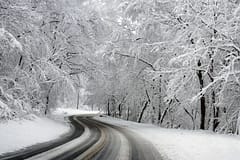
Snow Chains
Relying solely on your vehicle’s traction aids may not offer you the security you were expecting in such conditions. Traction control is an asset but when you’re two tons of pride and joy is sliding sideways it usually doesn’t help. Without using chains, there are times when it may be of benefit to reduce tyre pressures to increase the tyre “footprint” (think snow shoes) assuming you have a means to re-inflate. Be aware of possible sidewall damage and make sure your re-inflate for normal road use.
If you do purchase chains, ensure that they are suitable for your particular vehicle also make sure that you undertake instruction from your supplier on how to fit them. Make sure you practise this before the snows arrive, as then is not the time to start to learn. Incorrect or rushed fitment can lead to damage to the tyres and surrounding under vehicle components such as brake lines. With some vehicles, it may not be possible to fit chains to the front wheels due to the type of suspension as they may catch on these due to insufficient clearances. The same applies should you have fitted larger size tyres to standard without the necessary suspension upgrade to match.
Remember the No. 14 point made earlier:
The recommendations are always to fit chains to all 4 wheels however. If only 2 chains are available, fit these to the rear wheels while ascending (but be aware of the steering limitations on ascents as the front wheels will become lighter as the weight transfers to the rear).
Fit chains to the front wheels while descending but remember the rear will become lighter.
When driving on more normal terrain fit the chains to the front wheels front as this assists directional control. Be aware that although you have front directional control, the rear may slide if you drive aggressively
General Snow Driving
Earlier I mentioned staying in the ruts when driving regular tracks, as this should keep you from sliding off into ditches and gullies. Of course, you need to drive with awareness if the ruts have not been previously driven that day as they are likely to be snow filled and you will have no perception of their depth so you could easily finish up caught up by your differentials on the centre ground.
If driving in open ground where your colleague’s vehicles may have driven already, it is usually better for you to drive outside their wheel traces as you will gain more traction on the virgin snow.
Remember, if the snow depth is deeper than your front bumper bar then it is likely that you may not progress very far. Avoid the temptation to charge drifts to push your way through as often you will finish up sat on top of the snow that builds up below the vehicle with all four of your wheels off the ground. This particularly applies if you have bash plates under the vehicle as you just sledge up onto the snow and compact it.
Now is the time to mention “Mechanical Sympathy,” especially for the steering box, steering hydraulics and brake hoses. Deep snow builds up under the front wings and gets trapped and compacts between those and the chassis rails. The more you try and turn the steering, the more pressure you put on the steering hydraulics and this will lead to the various steering box seals leaking, the steering pump screaming its head off and possible distribution belt damage. If you hear the pump screaming it’s an indication of compacted snow so STOP and clear it away.
In amongst the compacted snow trapped under the vehicle there may well be small twigs and branches that have been broken off nearby trees and balled up in the snow. If these have any strength or length and wrap around a brake hose and then become caught under a wheel, the force and strain can rip a brake hose. When you do clear under the wing and chassis area make sure you do it gently and not with a sharp spade or similar as again you could cause damage to any pipework. At all times, avoid excessive acceleration and braking, drive smoothly and make sure that you keep a good distance between any accompanying vehicles. If you have climbs or descents, do a ground recce first to check the terrain and snow depth as well as the usual hazard and run out area checks just in case things go wrong. In snow conditions, they DO. Make sure other vehicles are well clear before you attempt these obstacles and that you are clear before they attempt them. Often it is better to “Marshall” and guide each other through difficult areas.
Taking turns to get up the slope

Tail Piece
Well, we have covered the basics, which will hopefully benefit you when faced with Snow and Ice conditions, but I have left a few points to the end so they are up front in your memory banks.
- When you find your vehicle is covered in snow, before you drive off in it make sure that you clear it off the roof, hood/bonnet, windows and mirrors. Don’t try and brush it off the windscreen with the wipers still down as you may damage them. Lift the wipers up and clean the blades. Scrape ice off all the windows (not just a peep-hole). The reason for clearing all the snow off the roof and hood/bonnet is so it doesn’t either drop off or blow up and distract you or disrupt either your vision or that of those following. Don’t forget to clean ALL your exterior lights and indicators. You will have seen un-cleared vehicles driving around – Don’t be one of them!
- While you have been clearing snow or even just walking around your vehicle, your footwear will be covered in the stuff and the sole treads filled with it. Make sure you kick them on the side step or similar before you get in to the driving seat to clear them. Two reasons for this, if you have slippery footwear your feet may slip off the pedals at a crucial time. If you bring snow into the vehicle foot-well, it falls off and melts and with the vehicle interior heater the condensation will form on your windows and screen.
- ALWAYS make sure you have a GOOD Battery and that the charging system is working correctly. Cold weather plays havoc with weak batteries. Whether Manual or Automatic, take a set of Jump Leads with you so you can either start your engine from another vehicle or a spare battery you have taken with you.
- Make sure you check and top up your engine, steering, radiator, brake, clutch and also axle fluids. DON’T Forget the Windscreen Washer bottle top that up and take some spare winter screen wash.
- Don’t forget to pack all your Vehicle Recovery Gear
- Where you can, take some flasks of Hot Water, Soup to warm you up when needed. This will give you the psychological boost just at the right time. Also a good idea to pack a towel to dry you off if you get wet through carrying out recoveries etc.
IMPORTANT: No Summary for the SNOW article – JUST RE-READ IT – TWICE!
Enjoy your winter and stay safe
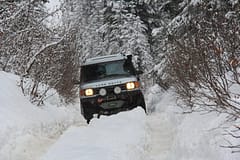
Previous Article: How to Drive on Sand Without Getting Stuck
Next Article: How to Cross a Ditch With or Without Air Suspension
Copyright
This content was prepared for the Off-Road Discovery Website by Xplorability 4wd Training
The Content - All Photographs and Photographic Copyright and All other Rights other Reserved October 2017. S.W. France. This content may not be copied or reproduced without the written consent of Paul Sinkinson – Xplorability Training.
For Use Only in 4wd and Light Vehicle Driver Training.
Not for Re-Publication, Distribution or use outside the Xplorability Training Programme
